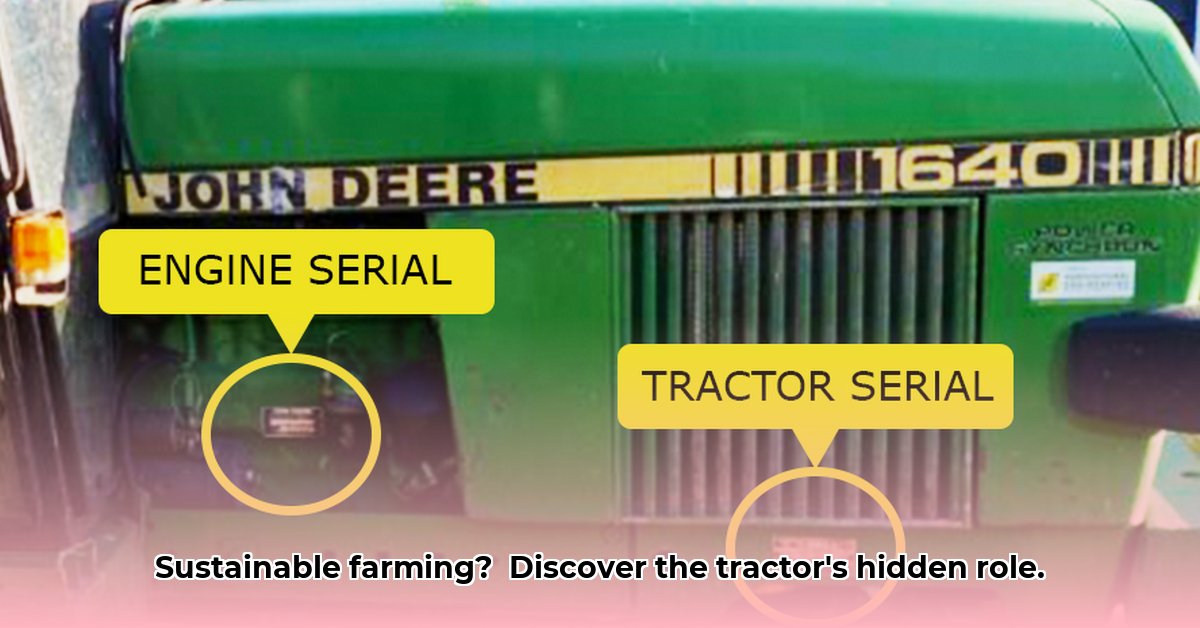
Tractor Serial Numbers: Your Key to Sustainable Agriculture
Keeping your farm equipment running efficiently is vital for sustainable agriculture. Yet, maintaining older tractors can be challenging. Finding parts, scheduling timely maintenance, and understanding fuel consumption can feel overwhelming. But there's a simple solution: your tractor's serial number. This seemingly insignificant string of numbers and letters holds a wealth of information that can significantly improve your farming practices. For help with older models, check out this helpful resource on old John Deere tractors. This guide will teach you how to utilize this information to improve efficiency and sustainability on your farm.
Locating Your Tractor's Serial Number
The first step is finding the serial number itself. This unique identifier, often stamped on a metal plate, is like your tractor's "birth certificate". Its location varies by manufacturer and model.
Step 1: Consult Your Owner's Manual: Your owner's manual should clearly indicate the serial number's location. If your owner's manual is lost or damaged, proceed to step 2.
Step 2: Visual Inspection: Systematically inspect your tractor. Look for a metal plate featuring numbers and/or letters. Common locations include: the engine block, the chassis (often underneath), the transmission, or inside the operator's cab (if equipped).
Step 3: Online Resources: If the number remains elusive, search online for "[your tractor make and model] serial number location". Many forums and websites provide visual guides and helpful tips.
Step 4: Documentation: Once located, photograph or record the serial number. Store this information securely with your tractor's maintenance records. This prevents future searches and ensures ready access.
Decoding Your Tractor's Serial Number
Tractor serial numbers follow varying formats depending on the manufacturer (e.g., John Deere, Case IH, New Holland, Kubota). However, the numbers generally encode key information about your tractor. This might include the year of manufacture, the specific model, and sometimes even the production sequence.
While the exact format varies, a common structure might include: YYYYMMDD-XXX (where YYYY represents the year, MM the month, DD the day, and XXX represents model-specific information). Manufacturer websites and online manuals can usually decipher your tractor's specific code. Have a question about a particular sequence? Consult online databases or tractor forums.
Practical Applications for Sustainable Farming
Knowing your tractor's serial number unlocks several advantages for sustainable farming:
1. Precision Maintenance: The tractor's age, readily determined from the serial number, allows for appropriate maintenance scheduling, preventing major breakdowns and maximizing operational efficiency. This extends the tractor's lifespan, saving your financial investment and reducing environmental waste from premature replacement.
2. Streamlined Parts Sourcing: When ordering replacement parts, the serial number ensures you receive the correct components, minimizing downtime and reducing the risk of ordering incorrect, unusable parts. This improves efficiency and reduces waste.
3. Fuel Efficiency Assessment: Older tractors often consume more fuel than newer models. Comparing this data to your tractor's age (determined from the serial number) reveals fuel consumption patterns, leading to potential cost savings and a reduced environmental impact.
4. Regulatory Compliance: Your tractor's age, as determined by its serial number, might affect emissions standards and regulatory compliance. Understanding these factors ensures you meet relevant requirements.
5. Informed Equipment Lifecycle Management: This helps with evaluating the need for upgrades. Knowing your tractor's age allows informed decision-making regarding upgrades, which helps avoid unnecessary purchases and promotes a more sustainable approach to equipment management.
Record Keeping: A Foundation for Sustainable Practices
Maintaining detailed records is essential. Keep your tractor's serial number, all repair details, and maintenance logs in a readily accessible and secure location. This comprehensive record is invaluable for efficient maintenance, accurate repair history, and potential insurance claims. This detailed approach reduces costs associated with repeated repairs or parts replacement.
Valuable Resources
Manufacturer websites offer detailed information. Parts suppliers often possess valuable insights about your tractor's history and spare parts. Online forums focusing on specific tractor makes and models provide access to a community of enthusiasts and experts ready to assist.
In conclusion: Your tractor's serial number is far more than just a code; it unlocks practical information which can significantly improve your farming practices and promote sustainability. Utilize it to optimize your farm's operations for years to come.